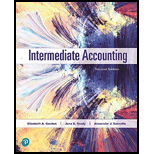
Intermediate Accounting (2nd Edition)
2nd Edition
ISBN: 9780134730370
Author: Elizabeth A. Gordon, Jana S. Raedy, Alexander J. Sannella
Publisher: PEARSON
expand_more
expand_more
format_list_bulleted
Question
Chapter 6, Problem 6.4E
To determine
To classify: The given accounts in assets, liability and equity.
Expert Solution & Answer
Want to see the full answer?
Check out a sample textbook solution
Students have asked these similar questions
I want to correct answer general accounting question
On January 1, Silverstone Co. issues bonds
with a face value of $400,000 and an interest
rate of 8%, payable semi-annually. What is the
amount of interest expense on July 1?
How much long term debt does omega solutions have of this financial accounting question?
Chapter 6 Solutions
Intermediate Accounting (2nd Edition)
Ch. 6 - What are the limitations of the balance sheet?Ch. 6 - What does a firms liquidity measure?Ch. 6 - Prob. 6.3QCh. 6 - What are the four major components of stockholders...Ch. 6 - Prob. 6.5QCh. 6 - Prob. 6.6QCh. 6 - Where is accumulated other comprehensive income...Ch. 6 - Prob. 6.8QCh. 6 - Prob. 6.9QCh. 6 - What are the two main balance sheet formats?...
Ch. 6 - Prob. 6.11QCh. 6 - Prob. 6.12QCh. 6 - What are the two formatting options for reporting...Ch. 6 - What is financial statement articulation?Ch. 6 - How is net income closed? Is the closing entry the...Ch. 6 - Why are the notes to the financial statements an...Ch. 6 - Prob. 6.17QCh. 6 - What is a subsequent event?Ch. 6 - What is a subsequent event under IFRS?Ch. 6 - How do firms report a material subsequent event on...Ch. 6 - Prob. 6.21QCh. 6 - Over what period must management assess the...Ch. 6 - Prob. 6.23QCh. 6 - Prob. 6.24QCh. 6 - Prob. 6.25QCh. 6 - Prob. 6.26QCh. 6 - Prob. 6.27QCh. 6 - Prob. 6.28QCh. 6 - Prob. 6.29QCh. 6 - Prob. 6.30QCh. 6 - Prob. 6.31QCh. 6 - Who is responsible for designing and implementing...Ch. 6 - Prob. 6.33QCh. 6 - What are the two key measures of liquidity?...Ch. 6 - What does the debt-to-equity ratio measure for a...Ch. 6 - What does a high current ratio indicate about a...Ch. 6 - Is it useful to compare working capital among...Ch. 6 - Sykes Corporations comparative balance sheets at...Ch. 6 - During Year 1, Brianna Company had the following...Ch. 6 - Which of the following items would not be included...Ch. 6 - Kong Co. purchased a three-month U.S. Treasury...Ch. 6 - Prob. 6.5MCCh. 6 - Prob. 6.6MCCh. 6 - In its year-end income statement, Black Knights...Ch. 6 - On is current year income statement, Vegas...Ch. 6 - Advantages of the Statement of Financial Position....Ch. 6 - Prob. 6.2BECh. 6 - Prob. 6.3BECh. 6 - Account Classification: Current and Noncurrent...Ch. 6 - Classified Balance Sheet. Armstrong Associates...Ch. 6 - Classified Balance Sheet, Report Format. Martell...Ch. 6 - Classified Balance Sheet, Account Format. Using...Ch. 6 - Classified Balance Sheet. Report Format.Bowe...Ch. 6 - Classified Balance Sheet, Account Format. Using...Ch. 6 - Classification as Operating. Investing, or...Ch. 6 - Prob. 6.11BECh. 6 - Classification as Operating, Investing, or...Ch. 6 - Classification as Operating. Investing, or...Ch. 6 - Classification as Operating, Investing, or...Ch. 6 - Classification as Operating, Investing, or...Ch. 6 - Classification as Operating, Investing, or...Ch. 6 - Classification as Operating, Investing, or...Ch. 6 - Prob. 6.18BECh. 6 - Statement of Cash Flows, Indirect Method. Identity...Ch. 6 - Financial Statement Articulation. Complete the...Ch. 6 - Prob. 6.21BECh. 6 - Prob. 6.22BECh. 6 - Prob. 6.23BECh. 6 - Prob. 6.24BECh. 6 - Statement of Cash Flows, Indirect Method. Tennis...Ch. 6 - Statement of Cash Flows, Direct Method. Use the...Ch. 6 - Prob. 6.27BECh. 6 - Ratio Analyses. Green Grasshopper Incorporated is...Ch. 6 - Classification of Assets and Liabilities. Darin...Ch. 6 - Prob. 6.2ECh. 6 - Prob. 6.3ECh. 6 - Prob. 6.4ECh. 6 - Prepare Balance Sheet. Blackburn Building Products...Ch. 6 - Prepare Balance Sheet. Lake Company provided the...Ch. 6 - Statement of Cash Flows, Indirect Method. Tulsa...Ch. 6 - Prob. 6.8ECh. 6 - Prob. 6.9ECh. 6 - Prob. 6.10ECh. 6 - Prob. 6.11ECh. 6 - Financial Statement Articulation. Use the...Ch. 6 - Prob. 6.13ECh. 6 - Prob. 6.14ECh. 6 - Prob. 6.15ECh. 6 - Prob. 6.16ECh. 6 - Prob. 6.17ECh. 6 - Solvency Analyses. The following items are from...Ch. 6 - Prepare Balance Sheet. Larkin Corporation provided...Ch. 6 - Prob. 6.2PCh. 6 - Prepare Balance Sheet. Jennings Incorporated...Ch. 6 - Prepare Stockholders Equity Section of Balance...Ch. 6 - Prepare Stockholders Equity Section of Balance...Ch. 6 - Prepare Classified Balance Sheet.Centre Company...Ch. 6 - Prepare a classified balance sheet at December 31...Ch. 6 - Contents of the Annual Report, Financial Statement...Ch. 6 - Statement of Cash Flows, Operating Activities...Ch. 6 - Statement of Cash Flows, Operating Activities...Ch. 6 - Statement of Cash Flows, Direct Method. Prepare...Ch. 6 - Statement of Cash Flows, Indirect Method. Prepare...Ch. 6 - Prob. 6.13PCh. 6 - Statement of Cash Flows, Operating Activities...Ch. 6 - Statement of Cash Flows, Direct Method. Prepare...Ch. 6 - Prob. 6.16PCh. 6 - Prob. 1JCCh. 6 - UseFoot Locker. Inc.sbalance sheet and other...Ch. 6 - Prob. 1SSCCh. 6 - Surfing the Standards Case 2: True and Fair...Ch. 6 - Basis for Conclusions Cases Basis for Conclusions...Ch. 6 - Prob. 2BCC
Knowledge Booster
Similar questions
arrow_back_ios
SEE MORE QUESTIONS
arrow_forward_ios
Recommended textbooks for you
 Cornerstones of Financial AccountingAccountingISBN:9781337690881Author:Jay Rich, Jeff JonesPublisher:Cengage LearningPrinciples of Accounting Volume 1AccountingISBN:9781947172685Author:OpenStaxPublisher:OpenStax College
Cornerstones of Financial AccountingAccountingISBN:9781337690881Author:Jay Rich, Jeff JonesPublisher:Cengage LearningPrinciples of Accounting Volume 1AccountingISBN:9781947172685Author:OpenStaxPublisher:OpenStax College College Accounting (Book Only): A Career ApproachAccountingISBN:9781337280570Author:Scott, Cathy J.Publisher:South-Western College Pub
College Accounting (Book Only): A Career ApproachAccountingISBN:9781337280570Author:Scott, Cathy J.Publisher:South-Western College Pub

Cornerstones of Financial Accounting
Accounting
ISBN:9781337690881
Author:Jay Rich, Jeff Jones
Publisher:Cengage Learning

Principles of Accounting Volume 1
Accounting
ISBN:9781947172685
Author:OpenStax
Publisher:OpenStax College


College Accounting (Book Only): A Career Approach
Accounting
ISBN:9781337280570
Author:Scott, Cathy J.
Publisher:South-Western College Pub